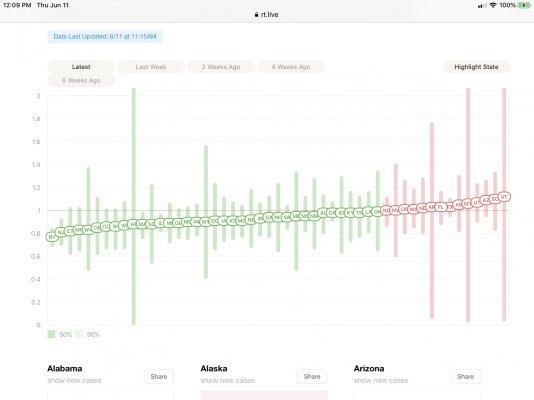From early in the article:
"ABC News' analysis of state data compiled by the COVID Tracking Project, a volunteer project launched by The Atlantic, further showed that five states had mostly flat hospitalization rates, while the majority of states, 37, saw a downward trend."
So doing some quick math, there are about 8 states where things are getting worse, presumably the 8 states featured in the article.
I think there is an attempt by news organizations to develop a narrative here. If most states are opening up, and most states are seeing a downward trend, then logic would say that opening up is generally OK. Unless the states that are opening up faster or more are correlated to the states that are having more problems, which the article didn't seem to attempt to try to do from the portions of it that I read.
Further, there are counterexamples, such as my own state, where states are opening up and not seeing second waves (yet). Since most states are reopening, and in 37 states the trend is downward, it seems like there would easily be 8 states or even more where things are getting better and they are opening up. But they didn't interview health experts in any of those states.
The other thing I wonder about and would like to ask here: When should we expect to see the second wave? In my state, we've been opening up for approximately six weeks, and yet the curve has clearly been flattening (
https://covid19.healthdata.org/united-states-of-america/idaho). One could even, based on the data, make the nonsensical assertion that reopening has resulted in a slowdown in cases. After all, the reopening has been occurring and after that point in time the slowdown occurred.
I can understand the idea that there would be some lag between infections and cases, but I think we should have seen it by now. Idaho's recommendations - and I think these are common across many portions of the rest of the world - are for quarantines to last 14 days. I know that's a somewhat arbitrary number, but it seems like a good proxy for the lag period.
The article talks about people's practices as distinct from the reopening guidelines as a possible explanation. I think this could be part of the explanation. My state has seen an uptick in activity, and a drop off in mask-wearing and social distancing compared to the lockdown period. But we've also, like everywhere else, started installing plexiglass all over the place, and there still is distancing and mask wearing among maybe half of the population. I think most people have been mostly compliant with the state's orders.
I know I'm being a tad contrary, but I'd really like to understand how the second wave theory applies to my state, to see what I may be missing in my understanding of the situation. So thanks in advance to anyone who answers, I really do appreciate it.


